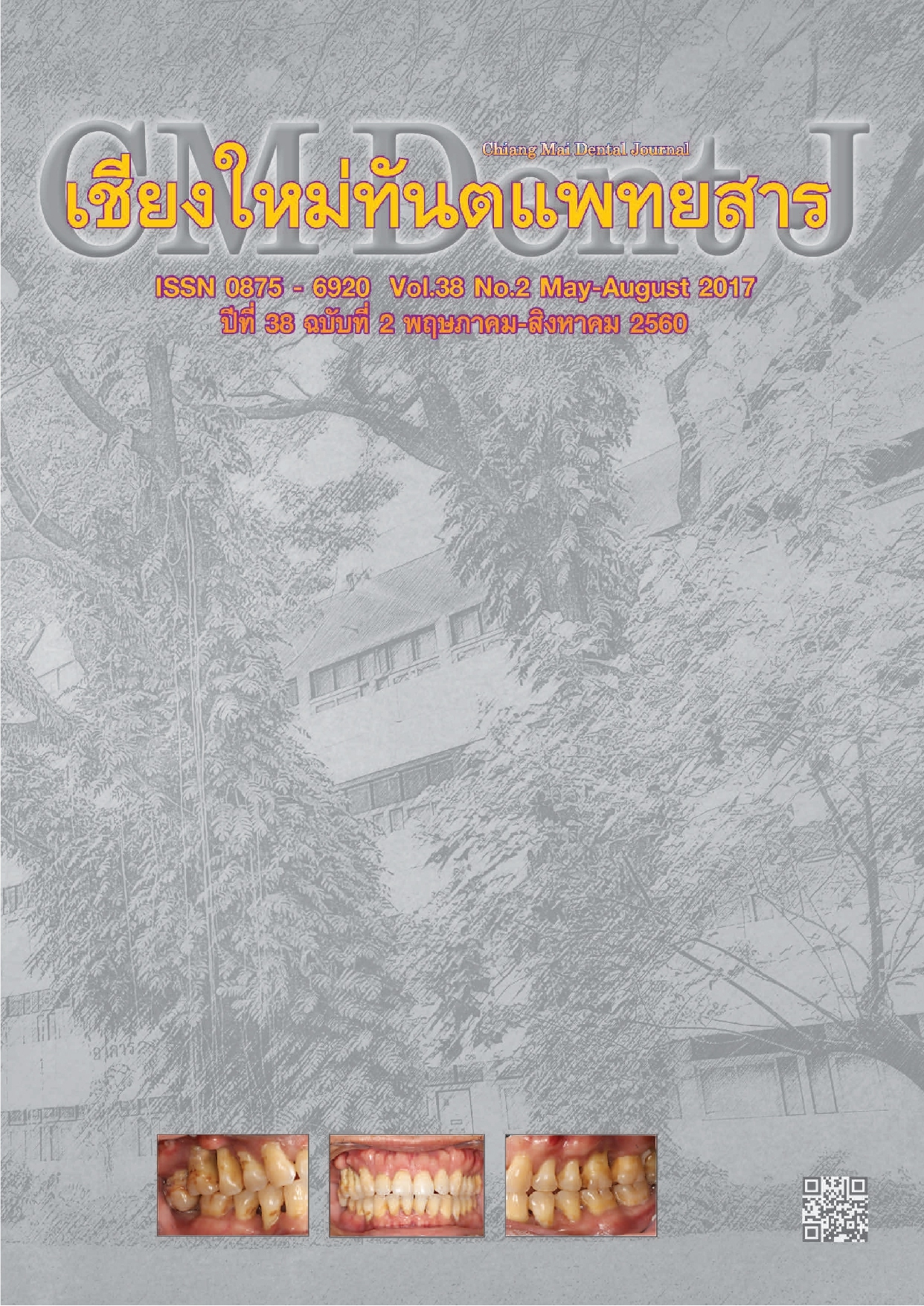The stability of Three-thread-design dental implants during the healing period. A clinical study using resonance frequency analysis method
Main Article Content
Abstract
Dental implants have shown a high success rate for rehabilitation of edentulous patients if certain conditions are met during treatment. Primary implant stability is the main factor in the success of osseointegration. Secondary implant stability is gained by osseointegration during the healing period. The purposes of this study were to examine the primary stability of three-thread-design dental implants and to monitor the stability of dental implants during a three-month period using the resonance frequency analysis (RFA) method. Twelve patients received 16 dental implants (PW Plus, Nakhon Pathom, Thailand). The dental implants were placed in the posterior mandibular edentulous area. At implant placement and after 1, 2, 3, 4, 6, 8, 10 and 12 weeks, RFA assessments were performed. The results showed that the mean primary implant stability quotient (ISQ) value was 77.2±0.93 and there was a statistical decrease in the mean ISQ values at the first week (P < 0.05). After that, the mean ISQ values constantly increased in the following weeks. However, the dental implants showed high stability over the three-month period (ISQ ≥ 65). Within the limitations of this study, our results show that the three-thread-design implant reveals high stability throughout the healing period.
Article Details
References
Brånemark PI, Adell R, Breine U, Hansson BO, Lindström J, Ohlsson A. Intra-osseous anchorage of dental prostheses. I. Experimental studies. Scand J Plast Reconstr Surg 1969; 3(2): 81–100.
Roberts WE. Bone tissue interface. J Dent Educ 1988; 52(12): 804–809.
Khongkhunthian P. PW Plus Thai Dental Implant. 1st ed. Bangkok: STZ Mospace design; 2015: 12.
Meredith N, Shagaldi F, Alleyne D, Sennerby L, Cawley P. The application of resonance frequency measurements to study the stability of titanium implants during healing in the rabbit tibia. Clin Oral Implants Res 1997; 8(3): 234–243.
Meredith N, Book K, Friberg B, Jemt T, Sennerby L. Resonance frequency measurements of implant stability in vivo. A cross-sectional and longitudinal study of resonance frequency measurements on implants in the edentulous and partially dentate maxilla. Clin Oral Implants Res 1997; 8(3): 226–233.
Heo SJ, Sennerby L, Odersjö M, Granström G, Tjellström A, Meredith N. Stability measurements of craniofacial implants by means of resonance frequency analysis. A clinical pilot study. J Laryngol Otol 1998; 112(6): 537–542.
Rasmusson L, Kahnberg K-E, Tan A. Effects of Implant Design and Surface on Bone Regeneration and Implant Stability: An Experimental Study in the Dog Mandible. Clin Implant Dent Relat Res 2001; 3(1): 2–8.
Friberg B, Sennerby L, Linden B, Gröndahl K, Lekholm U. Stability measurements of one-stage Brånemark implants during healing in mandibles. Int J Oral Maxillofac Surg 1999; 28(4): 266–272.
Meredith N. Assessment of implant stability as a prognostic determinant. Int J Prosthodont 1998; 11(5): 491–501.
Rodrigo D, Aracil L, Martin C, Sanz M. Diagnosis of implant stability and its impact on implant survival: a prospective case series study. Clin Oral Implants Res 2010; 21(3): 255–261.
Kokovic V, Jung R, Feloutzis A, Todorovic VS, Jurisic M, Hämmerle CHF. Immediate vs. early loading of SLA implants in the posterior mandible: 5-year results of randomized controlled clinical trial. Clin Oral Implants Res 2014; 25(2): e114–119.
Benic GI, Mir-Mari J, Hämmerle CHF. Loading protocols for single-implant crowns: a systematic review and meta-analysis. Int J Oral Maxillofac Implants 2014; 29 Suppl: 222–238.
Mühlemann HR, Son S. Gingival sulcus bleeding--a leading symptom in initial gingivitis. Helv Odontol Acta 1971; 15(2): 107–113.
Löe H. The Gingival Index, the Plaque Index and the Retention Index Systems. J Periodontol 1967; 38(6): Suppl:610–616.
Yang S-M, Shin S-Y, Kye S-B. Relationship between implant stability measured by resonance frequency analysis (RFA) and bone loss during early healing period. Oral Surg Oral Med Oral Pathol Oral Radiol Endod 2008; 105(2): e12–19.
Tallarico M, Vaccarella A, Marzi GC, Alviani A, Campana V. A prospective case-control clinical trial comparing 1- and 2-stage Nobel Biocare TiUnite implants: resonance frequency analysis assessed by Osstell Mentor during integration. Quintessence Int Berl Ger 1985 2011; 42(8): 635–644.
Ersanli S, Karabuda C, Beck F, Leblebicioglu B. Resonance frequency analysis of one-stage dental implant stability during the osseointegration period. J Periodontol 2005; 76(7): 1066–1071.
Han J, Lulic M, Lang NP. Factors influencing resonance frequency analysis assessed by Osstell mentor during implant tissue integration: II. Implant surface modifications and implant diameter. Clin Oral Implants Res 2010; 21(6): 605–611.
Berglundh T, Abrahamsson I, Lang NP, Lindhe J. De novo alveolar bone formation adjacent to endosseous implants. Clin Oral Implants Res 2003; 14(3): 251–262.
Lekholm U, Zarb G, Albrektsson T. Patient selection and preparation. Tissue integrated prostheses. Chicago: Quintessence Publ Co Inc.; 1985: 199–209.


